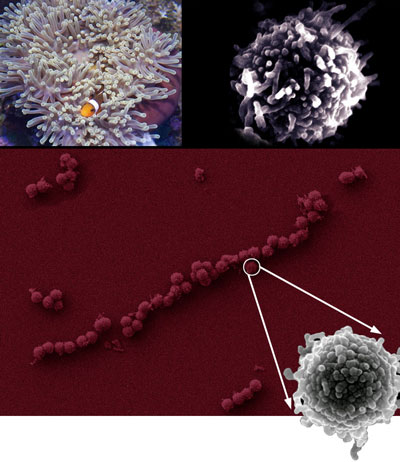| Posted: Jun 09, 2008 | |
Sea anemones inspire nanotechnology fabrication of tough nano-containers |
|
| (Nanowerk Spotlight) The addition of carbon nanotubes (CNTs), both single-walled and multi-walled, to various polymer matrices has produced significant improvements in strength and stiffness (see for instance: "Ultra-strong composite materials with nanotubes"). Reinforcing materials based on CNTs could be used to fabricate more complex nanostructures by making them tougher and stronger. | |
| As is the case so often, and covered quite extensively here at Nanowerk (see: "Trying to copy the greatest nanotechnologist of all") nature has served as an inspiring source of various morphologies and composite materials for nanotechnology techniques. New work by Spanish scientists demonstrates the fabrication of novel nanostructures that resemble magnificent sea anemones (heteractis magnifica), aiming at increasing the rigidity and the available surface of magnetic and reinforced CNTs-based hollow capsules. | |
| "The unique morphology of the rigid, hollow silica capsules that we fabricated results in a huge available surface area that can easily be tailored" Dr. Luis M. Liz-Marzán tells Nanowerk. "Moreover, the reinforcement of the silica capsules with CNTs, together with incorporation of a magnetic functionality, makes them exceptional structures where the functionality of every intrinsic component can be exploited within the whole." | |
| Liz-Marzán is a professor in the Department of Physical Chemistry at the University of Vigo in Spain where he leads the Colloid Chemistry Group. His group's most recent work has been published in the April 29, 2008 online edition of Small ("Magnificent Sea-Anemone-Like Magnetic Silica Capsules Reinforced with Carbon Nanotubes"). | |
 |
|
| Top left: heteractis magnifica; Top right: SEM image of hollow CNT–silica capsules fabricated with long (∼5–10µm) CNTs; Bottom: SEM image of the one-dimensional structures formed by the magnetic, hollow and reinforced capsules under an applied magnetic field. (Image: Miguel A. Correa-Duarte, University of Vigo) | |
| While the silica shell acts as a porous membrane providing rigidity to the capsule (and allowing their bioconjugation for different applications), CNTs serve as reinforcement and template for the branched shape of the structure. This composite results in thin capsules with improved mechanical properties which otherwise would be difficult to achieve. | |
| Liz-Marzán and his team start with an initial layer-by-layer (LbL) sequential adsorption of polyelectrolytes and CNTs onto submicrometer-sized polystyrene (PS) spheres. These PS-CNT composite particles can be converted into CNT-based hollow capsules by simply dissolving the spherical polymeric cores, however the resulting flexible capsules readily collapse when dried. | |
| "Further modification through subsequent coating with silica allowed us to create a new type of rigid branched capsule with a larger mechanical strength and an increased surface area that arises from their magnificent sea anemone-like nano-object" explains Dr. Miguel A. Correa-Duarte, a senior researcher in Liz-Marzán's group who was responsible for carrying out this work. | |
| He points out that the process used for silica coating of the PS–CNT nanocomposites was based on his group's previous work for the encapsulation of individual CNTs ("Carbon Nanotubes Encapsulated in Wormlike Hollow Silica Shells"). | |
| "This step is critical on the formation of these magnificent sea anemone-like hollow capsules because a controlled and selective silica deposition needs to be carried out to coat both the CNTs adsorbed onto the surface of PS template, as well as those partially protruding into solution, while avoiding silica nucleation in solution," Correa-Duarte describes this important step in the process. | |
| "Additionally" he explains, "further functionalization through adsorption of magnetic nanoparticles prior to CNTs deposition and silica coating leads to magnetic capsules, which can be assembled using an external magnetic field. The functionality of every intrinsic component of these exceptional structures can be exploited within the composite." | |
| "Such structures pave the way toward new applications, where more than one functionality per particle is required" he says. | |
| The approach taken by the University of Vigo researchers could solve problems in applications where robust capsules with thin, porous membranes are required. While the CNTs provide robustness, the control of capsule permeability can be easily solved through the silica shell thickness. Furthermore, the silica hydroxide ions at their surface allows their bioconjugation for specific applications. The incorporation of magnetic nanoparticles can also be exploited for magnetically controlled targeting. | |
| For all these reasons, these unique nanostructures offer interesting possibilities for use in potential nanotechnology applications such as controlled encapsulation and drug delivery or as nanoreactors for catalytic reactions. | |
| Liz-Marzán also mentions that the conductivity of partially desorbed silica-coated CNTs can be exploited for sensing applications upon selective removal of silica from their tips. His group also intends to carefully characterize the mechanical response, as compared to standard silica capsules. | |
 By
Michael
Berger
– Michael is author of three books by the Royal Society of Chemistry:
Nano-Society: Pushing the Boundaries of Technology,
Nanotechnology: The Future is Tiny, and
Nanoengineering: The Skills and Tools Making Technology Invisible
Copyright ©
Nanowerk LLC
By
Michael
Berger
– Michael is author of three books by the Royal Society of Chemistry:
Nano-Society: Pushing the Boundaries of Technology,
Nanotechnology: The Future is Tiny, and
Nanoengineering: The Skills and Tools Making Technology Invisible
Copyright ©
Nanowerk LLC
|
Become a Spotlight guest author! Join our large and growing group of guest contributors. Have you just published a scientific paper or have other exciting developments to share with the nanotechnology community? Here is how to publish on nanowerk.com.
